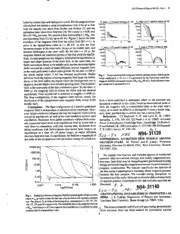
NASA Technical Reports Server (NTRS) 19940026634: Nonthermal accretion disk models around neutron stars PDF
Preview NASA Technical Reports Server (NTRS) 19940026634: Nonthermal accretion disk models around neutron stars
LPITechnical Report 94-03, Part I 9 "_jded by cosmic rays and radioactive nuclei. For the purpose of our T max=1.77yearsinstepsof.35 T_max=17.7 yearsinstepsof3.5 10,00o,001 ooot c_culations we assume asolar protoplanetary disk to be an ¢tdisk IO0.O0 with the opacity law taken from Ruden and Pollack [3] and the lO°t° \\\\\ 10,00 ionization state taken from Stepinski [4]. We choose ¢_- 0.08, and ,.foo 1°°°-°°l Ivl---10 -6M® per year. We assume adisk surrounding a l-M® star 10..0100 _ 0.10 + and extending from 0.2 AU up to 40 AU. Figure 2 shows the time 0,01! 0.01 L___---..----IL evoluiion of the magnetic field from the initial field Q(r) - 0.1 in 1 10 100 1 10 100 units of the equipartition value at r - 40 AU. At first the field T_max=177yearsinstepsof35 T max=1770 instepsof350 increasessharply at the inner radii, decays at the middle radii, and remains upchanged at the outer radii. By the time t - 10 yr, the 100.00 100.00 I magnetic fi_eldin the innermost portion of the disk achieves equilib- 10._ rim. As time progresses the magnetic field achieves equilibrium at larger and l_ger portions of the inner disk. At the same time, the 0.10 0,10[ field continue_ to decay at the middle radii, but the decaying region 0.011 0.01 | shifts outward:txs aresult of radial diffusion, and the magnetic field 1 10 100 1 10 100 in the outer par_$starts to show some growth. By the time t- 100 yr the whole regiola within 3 AU has reached equilibrium. Radial Fig.2. Timeevolutionofthe magnetic fieldinaprotoplanetarydiskfromthe diffusion from th:¢regions of strong magnetic field stops the further initialcondition Q- 0.1 att- 0 represented bythe horizontal solid line. decay of the field=within the region where the local growth rate is Magneticfield QismeasuredinunitsofBo-Beq(40AU). Radialdistance from negative, and the fieJd is now actually growing there. The magnetic thecentralstarismeasuredinAU. field in the outer par_ of the disk continues to grow. By the time t- 2000 yr, the magnetic field in almost the entire disk has reached equilibrium. Total equilibrium is achieved at roughly t- 4400 yr. The final configuration_ of the magnetic field follows closely the distribution of the equip±artition value magnetic field, except at the Such a field could have a substantial effect on the structure and middle radii. dynamical evolution of thin disks. From an observational point of Conclusions: The final configuration of adynamo-generated view, the magnetic field is concentrated close to the inner disk's magnetic field is independent of unknown initial conditions. How- radius, so it could be difficult to distinguish it from a stellar mag- ever, initial conditions influence the way the magnetic field evolves netic field, provided that acentral star has a strong field. toward its equilibrium, as well as the time needed to achieve such References: [11 Stepinski T. F. and Levy E. H. (1991) equilibrium. Evolution fromjnitial conditions without field rever- Astrophys. J., 379, 343-355. [2] Frank J. et al. (1985) Accretion sals (presented here) leads to'an equilibrium field in atime that is Power inAstrophysics, Cambridge Univ., Cambridge. [3] Ruden S. very short in comparison witfi disk viscous time. Evolution from P. and Poll ack J.B. (I99l)Astrophys. J., 375, 740-760. [4] Stepinski initial conditions with field re_rsals (not shown here) leads to an T. F. (1991) Icarus, 97, 130-141. O-- I equilibrium in a time 10-102 times longer, as radial diffusion A f. N94-31139 destroys field reversals. Inequilibrium, the field has amagnitude of the order of the equipartition with i,he kinetic energy of turbulence. NONTHERMAL ACCRETION D_SK MODELS AROUND NEUTRON STARS. M. Tavani I and E. Liang 2, |Princeton University, Princeton NJ 08544, USA, 2Rice University, Houston 10000.00 "IX77.251,USA. 1000.00 i We consider the structure and emission spectra of nonthermal 100.00 accretion disks around both strongly and weakly magnetized neu- i tron stars. Such disks may be dissipating their gravitational binding t_ 10.00 :; energy and transferring their angular momentum via semicontinuous _magnetic reconnections. We consider specifically the structure of O 1.00 ithe disk-steUar magnetospheric boundary where magnetic pressure :_';+=balances the disk pressure. We consider energy dissipation via 0.10 " _reconnection of the stellar field andsmall-scale disk turbulent fields (,') 0.01 +of opposite polarity. Constraints onthe disk emission spectrum are 0.001 0.010 0".i00 1.000 _discussed. p_ N94-31140 Flg.i. RadialdistributionofmagneticfieldQisplottedagafilstdimensionless GRAVITATIONAL INSTABILITIES IN PROTOSTELLAR radiusr/romatvarioustimesforthecaseofanaccretiondiskatpundacompact DISKS. J.E. Tohline, Department of Physics and Astronomy, star.Theplots (i-f), inorderofincreasingtime, correspondtol- I0, 102,103, Louisiana State University, Baton Rouge LA 70803, USA. l04, IOs,106,and 107srespectively.The dottedlineshowstheradiaIdistribution ofB_q.Afteraboutt- 10Vsthemagneticfieldequilibratesevery whereinadisk i The nonaxisymmetric stabilityofself-gravitating, geometrically atabout half the equipartition value. _ _thick accretion disks has been studied for protostellar systems I
